
by Heidi Copeland | Jan 29, 2020
We have a silent killer amongst us. It is the use and abuse of opioids! In fact, opioid use and abuse is a classified epidemic.
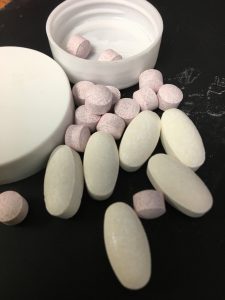
Too many pills?
Photo Source: Heidi Copeland
The opioid epidemic refers to the growing number of deaths and hospitalizations due to opioid use.
According the Centers for Disease Control and Prevention (CDC), overdose deaths from opioids, including prescription opioids, heroin, and synthetic illicit opioids (like fentanyl), have increased almost six times since 1999.
What is the appeal of opioid abuse? In the 2015 National Survey on Drug Use and Health (NSDUH), 11.5 million adults who abused prescription pain relievers at least once in the past year were asked their reasoning for misuse. The top answer included to relieve physical pain! (63.4%) Other reasons included relaxation, relieve tension, feel good, help with sleep, or to increase or decrease the effects of other drugs (Lipari, Williams, & Van Horn 2017).
There is no doubt that opioids are an effective pain reliever, however, the speed in which this abusive opioid epidemic has grown provides plenty of reasons everyone should be concerned. An opioid addiction can endanger the safety of each of us.
How did this epidemic begin? The epidemic stems from the late 1990’s. At the time, no one knew how quickly misuse of a prescription opioid could lead to an addiction. In a relatively short period of time opioid overdose rates, both prescription opioids as well as illicit synthetic opioids, skyrocketed. In the year 2017 alone, more than 47,000 Americans died as a result of an opioid overdose and 1.7 million individuals suffered from substance use relating to pain killers as a whole (NIH 2018).
The epidemic is also causing serious repercussions socially and economically. The Center for Disease Control and Prevention (CDC) estimates the total cost of opioid abuse to be a $78.5 billion a year and is a burden to our economy. Additional issues associated with opioid misuse can include loss of worker productivity, addictive behavior, and higher crime rates (Rich, Kornfield, Mayes, & Williams 2019).
Every individual can positively contribute to ending this epidemic. Get educated. Be aware of the signs of someone struggling with an opioid abuse and addiction. Recognize character traits associated with opioid abuse like loss of control, preoccupation with drug use, and willingness to continue using despite the negative consequences.
There are promising practices and resources to help end this epidemic. The U.S. Department of Health and Human Services (HHS) is directing their attention to this epidemic with efforts focused on (NIH 2018):
- improving access to treatment and recovery services
- strengthening our understanding of the epidemic through public health surveillance
- providing support for research on pain and addiction
- advancing alternative practices for controlling pain
As well, both National and State Prescription Drug Monitoring Programs (PDMP) are promising drug prevention tools.
Never doubt that a small group of thoughtful committed citizens can change the world; indeed, it’s the only thing that ever has. (Margaret Mead) Together, we can all do our part stop this epidemic.
Bailee Hurd, University of Florida Health Education Intern
Bonner, Michael. “’Opioids Are the Health Crisis of This Generation’.” Southcoasttoday.com, Southcoasttoday.com, 24 Sept. 2017, www.southcoasttoday.com/news/20170922/opioids-are-health-crisis-of-this-generation.
Lipari, Rachel, et al. “Why Do Adults Misuse Prescription Drugs?” Https://Www.samhsa.gov/Data/Sites/Default/Files/report_3210/ShortReport-3210.Html, Substance Abuse and Mental Health Services Administration, 27 July 2017, www.samhsa.gov/data/sites/default/files/report_3210/ShortReport-3210.html.
National Institute on Drug Abuse. “Opioid Overdose Crisis.” NIDA, 22 Jan. 2019, www.drugabuse.gov/drugs-abuse/opioids/opioid-overdose-crisis.
“Opioid Overdose.” Centers for Disease Control and Prevention, Centers for Disease Control and Prevention, 18 Oct. 2019, www.cdc.gov/drugoverdose/.
Rich, Steven, et al. “A New Look at How the Opioid Epidemic Evolved.” The Washington Post, WP Company, 23 Dec. 2019, www.washingtonpost.com/graphics/2019/investigations/opioid-pills-overdose-analysis/.

by Heidi Copeland | Jan 9, 2020
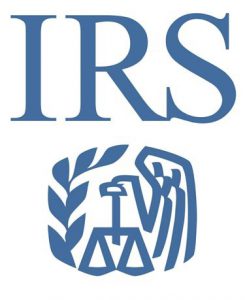
The deadline for filing your federal income tax return is April 15, 2020. (Photo source: IRS.gov)
The Internal Revenue Service has announced that they will begin accepting paper and electronic tax returns beginning January 27, 2020. The IRS encourages everyone to consider filing electronically and choosing direct deposit, as it is fast, accurate, and the best way to get your refund as quickly as possible.
Nonetheless, many software companies and tax professionals are accepting income tax return information now and promising instant refunds. KNOW that money being promised comes with a charge. As they say, there is NO free lunch, especially around tax time.
By law, the IRS cannot issue refunds for people claiming the Earned Income Tax Credit (EITC) or Additional Child Tax Credit (ACTC) before mid-February. The law requires the IRS to hold the entire refund − even the portion not associated with EITC or ACTC. This law change, which took effect in 2017, helps ensure that taxpayers receive the refund they are due by giving the IRS more time to detect and prevent fraud
The IRS also wants taxpayers to be aware it will take several days for these refunds to be released and processed through financial institutions. Factoring in weekends and the President’s Day holiday, the IRS cautions that many affected taxpayers may not have actual access to their income tax refunds until the end of February 2020.
The filing deadline to submit 2019 tax returns is Wednesday, April 15, 2020. Procrastinators can request a six-month extension to submit their returns (Form 4868), but you only have until midnight April 15, 2020 to pay taxes owed without penalty.
It is amazing to know that the IRS issues more than 9 out of 10 refunds in less than 21 days. Choosing e-file and direct deposit for refunds remains the fastest and safest way to file an accurate income tax return and receive a refund. However, it is possible your tax return may require additional review and take longer. Where’s My Refund? has the most up to date information available about your refund.
Your refund should only be deposited directly into accounts that are in your own name, your spouse’s name, or both if it is a joint account. No more than three electronic refunds can be deposited into a single financial account or pre-paid debit card. Taxpayers who exceed the limit will receive an IRS notice and a paper refund.
Whether you file electronically or on paper, direct deposit gives you safe access to your refund faster than a paper check.
Additional Resources:
Free Tax Return Prep for Qualifying Tax Payers (IRS)
What to Bring to Your Local VITA or TCE Site (IRS)

by Heidi Copeland | Sep 13, 2019
The American chestnut tree, (Genus: Castanea dentata, Species: C. sativa, Family: Fagaceae) is a large monoecious deciduous tree. This big, beautiful tree provides green shade in the summer, a stunning array of fall foliage and a spinney cupule (bur) that holds and protects the chestnut during its growth and maturation. As its leaves begin to fall, so does the bur whereupon it splits and releases the chestnut. The American chestnut is important for both food and forage. This was of course until the American chestnut tree was devastated by chestnut blight-a fungal disease (Cryphonectria parasitica)) where upon it has been estimated that between 3 and 4 billion American chestnut trees were destroyed in the first half of the 20th century.
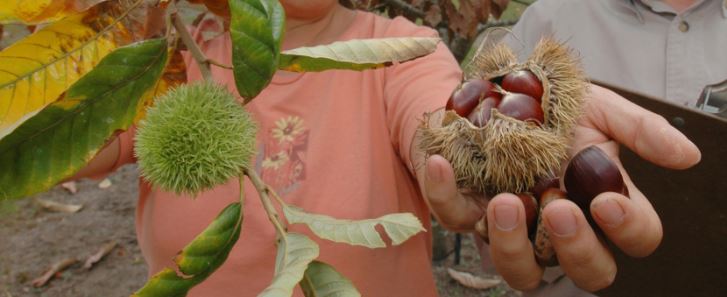
American/Chinese Chestnut
Photo Source UF/IFAS
However, through scientific research it has been discovered that the Chinese chestnut tree (Castanea mollissima) is recognized as being highly blight resistant (but not immune). Many places in the United States have replanted the American chestnut tree with the Chinese chestnut and its cultivars. In fact, there are several chestnut orchards.
The chestnut is classified as a nut.
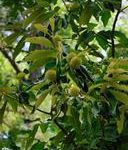
Chestnut Tree
Photo Source: Vern Wilkins, Indiana University, Bugwood.org
However, it differs from most nuts, as it is low in lipid (fat) content – approximately three percent. Nonetheless, the chestnut is nutritious; it contains carbohydrates, proteins and is rich in vitamins and minerals. The mature chestnut (nut pulp) is more than 50 percent water thus special care must be taken to extend its storage so that it does not spoil.
Local, fresh chestnuts are generally only available in the fall. A good chestnut is fairly large, firm to the touch and feels dense. The USDA does not have any standards for grades of chestnuts although sometimes size standards are based on the number of nuts per pound.
According to the American Chestnut Foundation® if fresh chestnuts are to be stored for eating, store them in a paper grocery bag for up to two months. Leaving fresh chestnuts at room temperature for a few days helps their starches convert to sugar. For longer storage, put chestnuts in the freezer and use immediately after thawing or they will become mushy.
Chestnuts can be eaten in a variety of forms –
- Fresh – dry roasted or boiled
- Frozen
- Dried
- Canned
- Pureed
- Ground into flour (obtained by grinding dried and peeled chestnuts)
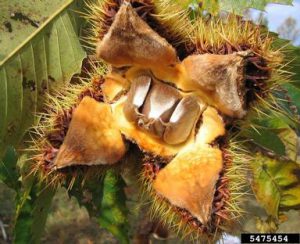
Three chestnuts inside the open but of the American Chestnut tree.
Photo Source: USDA Forest Service Southern Research Station, Bugwood.org
Cooking methods for chestnuts vary widely too. Customarily though, chestnuts are Dry-Roasted in the oven, over hot embers, on top of the stove in a skillet, or even in the microwave. Once peeled, the chestnut can be pureed, added to soups, stews, stuffing’s, and vegetable dishes or even turned into a decadent dessert.
- Heat a skillet on top of the stove or preheat the oven to 425° F
- Rinse the chestnuts in cold water. (this removes any bird droppings etc….)
- Using a sharp knife, score the flat side of each chestnut nut with “X”. (The chestnut is FULL of moisture, the “X” keeps it from exploding.)
- Using a roasting pan or skillet place the chestnuts in the oven, over an open fire, or on top of the stove.
- Dry roast, stirring every five minutes until the shells begin to split open. (At this point the shells are brittle and have curled back some at the X.)
- Remove from the heat when the insides feel soft. (This will depend on the nut but usually about 15 – 20 minutes.)
- Peel the shells off the chestnuts and enjoy warm or cold.
The internet contains a wealth of chestnut recipes. One I particularly enjoy is Chestnut Hummus. Instead of using your favorite bean, prepare a pound of chestnuts by either boiling or dry roasting.
When cool enough to handle toss all of the traditional hummus ingredients into a food processor and process until smooth. Serve in your favorite bowl drizzled with a bit of extra oil and favorite accoutrements.
Chestnut Hummus
1 pound prepared chestnuts
1 whole lemon, juiced
¼ cup tahini or 1/4 cup sesame oil
1-teaspoon cumin, whole or ground (or your favorite seasoning! – have you tried harissa?)
¼-cup oil
½ cup hot water, more if necessary to make a good spreading consistency
Salt to taste
Serve with your favorite accompaniments. (crackers, fresh sliced vegetables etc.)
Bon Appetite!

by Heidi Copeland | Jun 20, 2019
Part of cultivating a healthy, sustainable food system is to learning eat seasonally and locally. This means enjoying foods at their seasonal peak. In addition, there is value knowing when produce items are in season as these products are often tastier, healthier, fresher and more economical. Additionally, eating seasonally encourages a varied diet.
According to the Florida Department of Agriculture and Consumer Services (FDACS), Fresh From Florida produce is plentiful! The month of June is especially productive! June claims: Fresh From Florida avocado, cantaloupe, carambola, eggplant, guava, lychee, mango, mushroom, oranges, papaya, passion fruit, peanut, potatoes, sweet corn, tomatoes and watermelon!
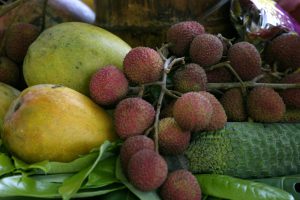
Tropical Fruit Day, 2005. UF/IFAS Photo Source: Thomas Wright.
Most of the listed produce items are pretty conventional. But what about something not so straightforward like the lychee?
The lychee (Litchi chinensis), linked to the Sapindus genus, is native to warm temperate tropical regions of southern China. The lychee is harvested ready to eat. The lychee is covered with a hard, non-edible covering and contains a crisp, juicy, sweet pleasant inner (tasting a bit like a cross between a strawberry and a grape). Lychee are a great source of nutrients, containing, energy (carbohydrates) as well as vitamins, minerals and fiber. Lychee can be consumed fresh off the tree, frozen, canned, pickled, dried or even as ingredients in salads, marinades, sauces or desserts.
Try it! You just might like it! The University Florida UF/IFAS Extension has a great publication if you are interested in growing lychee. https://edis.ifas.ufl.edu/pdffiles/MG/MG05100.pdf The World Wide Web has a plethora of interesting recipes for the lychee as well that you can check out.
Lychee Growing in the Florida Home Landscape https://edis.ifas.ufl.edu/pdffiles/MG/MG05100.pdf
Florida Crops in Season https://www.freshfromflorida.com/Consumer-Resources/Buy-Fresh-From-Florida/Crops-in-Season

by Heidi Copeland | Apr 30, 2019
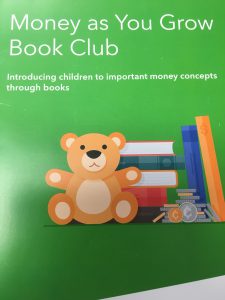
The Consumer Financial Protection Bureau, (CFPB) has defined financial capacity as a the combination of attitude, knowledge, skills, and self-efficacy needed to make and exercise money management decisions that best fit the circumstances of one’s life, within an enabling environment that includes, but is not limited to, access to appropriate financial services.
Many of the attitudes, knowledge and skills needed to build financial capacity can be learned. People learn behavior through a variety of contexts. Children, in particular, learn through practices modeled by a parent or caregiver. In fact, research shows that parents and caregivers have the most influence on their children’s financial capability.
If you are like most parents, you probably recognize this—and you are interested in setting your kids on a good path toward financial well-being. However, many parents also say they do not always have time, tools, or personal confidence to start talking about money thinking their children will learn about it in school, later on, when they are old enough to understand.
This is most unfortunate. According to the Council for Economic Education 2018 Survey of the States, only 17 States require high school students to take a course in personal finance. So, if a parent isn’t teaching their children basic money/financial skills who is? Economical and financial literacy is a foundational element to achieving financial health and financial well-being. It is never too early (or too late) to start building this.
Talking to children about money, even in EARLY CHILDHOOD, helps children build the skills they need later in life. Early childhood education experts like to call this scaffolding. You are setting the framework…the support…the platform, encouraging financial capability milestones from early childhood into young adulthood. Children can learn the behaviors, knowledge, skills, and personal characteristics that support financial health and well-being.
Books can help start these critical early conversation. The CFPB has made it EASY! Parents can be their child’s first financial capability teacher! The University of Wisconsin-Extension Family Living Programs and the University of Wisconsin-Madison Center for Financial Security have selected books for the CFPB Money as you Grow Book Club. This program uses easy to read and understand children’s books to discuss money concepts. These books include many favorites:
- A Bargain for Frances, by Russell Hoban
- A Chair for My Mother, by Vera Williams
- Alexander, Who Used to Be Rich Last Sunday, by Judith Viorst
- Count on Pablo, by Barbara deRubertis
- Cuenta con Pablo, by Barbara deRubertis
- Curious George Saves His Pennies, by Margaret and H.AS. Rey
- Just Shopping With Mom, by Mercer Mayer
- Lemonade in Winter, by Emily Jenkins
- My Rows and Piles of Coins, by Tololwa M. Mollel
- Ox-Cart Man, by Donald Hall
- Sheep in a Shop, by Nancy Shaw
- The Berenstain Bears & Mama’s New Job, by Stan & Jan Berenstain
- The Berenstain Bears’ Trouble With Money by Stan and Jan Berenstain
- The Purse, by Kathy Caple
- The Rag Coat, by Lauren Mills
- Those Shoes, by Maribeth Boelts
- Tia Isa Wants a Car, by Meg Medina
- Tia Isa Quiere un Carro, by Meg Medina
Fortunately, many of the building blocks for good financial decision making – like self-regulation, patience, planning, and problem-solving – do not require a lot of financial know-how.
Reading books with children is a creative way to learn about the many sides of money management. Pick up a few of the titles at your local library and influence your children’s financial capability. Building good habits leads to a life of good financial health and well-being.
Example of key ideas from reading books:
| PLANNING |
How Children Show It |
| Making Decisions |
Can look at a few choices and select on what will bring the best results. |
| Setting Goals |
Can follow a multi–step plan. |
| Prioritizing |
Can prioritize choices when they want two or more things at once. |
| Solving problems
|
Can describe problems and come up with a few idea to make things better. |
| MONEY |
|
| Earning |
Can identify the different jobs people in the family and in the community do to earn money and keep it safe. |
| Spending |
Make spending choices with their own money – real or play. |
| Saving |
Keeps money in a safe place and keeps track of amount saved for future spending. |
| Sharing and borrowing |
Can explain the difference between lending and giving something away. |
| ME |
|
| Self-control |
Can talk about times when they were able to wait and how they were able to do it. |
| Follow-through |
Can identify who they can turn to for help reaching a goal, or what tools or tricks might help them stick with a plan. |
| Staying true to yourself |
Name one special thing they like about themselves and their loved ones. |
| Flexibility |
Can talk about a time when their plans did not turn out how they wanted and what they did instead. |
Resource: https://www.consumerfinance.gov/consumer-tools/money-as-you-grow/












